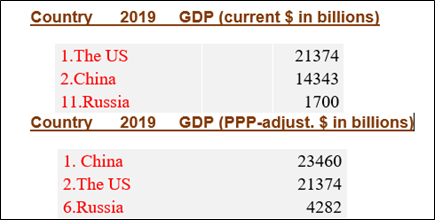Economic base
Biggest national economies in the world in 2019, according to World Bank statistics:

Two different views, current versus purchasing power parity, change the picture in international comparisons: China and Russia rise significantly in all such comparisons and “traditional” Western countries like the US will fall down. Purchasing power parity exchange rate is used when comparing national production and consumption and other places where the prices of non-traded goods are considered important. PPP rates are more stable over time and can be used when comparing different countries and their different important attributes.
The United States is the biggest economy when calculated in the current dollars but China’s forward march is overwhelming in all other indicators and metrics. When considering the GDP in PPP metrics, China overtakes the US, reaching top place and Russia is scoring sixth position.
What is also important to notice, is the total growth rate of GDP with PPP-adjusted in 1993-2018 Here China’s GDP has grown by multiplier 14,7 and India scores 8,0 respectively, Russia has a multiplier of 4,3 and the US has a multiplier of 3,0. However, Russia has been under severe sanctions and other punitive restrictions (by the US and EU) and suffered two national economic collapses as well.
Second key driver, besides GDP of the state, is the size of the population. According to UN (World Population Prospects, the 2019 Revision), the population statistics seem to be the following:

Third key driver is the size of the territory possessed by the state. (UN Statistics).

To sum up: the US, China and Russia are all economically great powers but teh US position is weakening considerably and the future perspective seems less positive (indebtedness, energy, strategic minerals and know-how).


